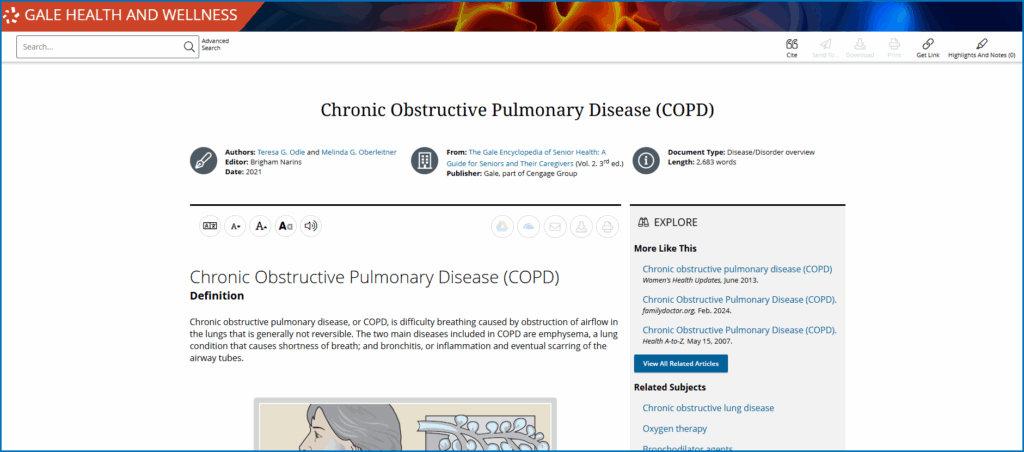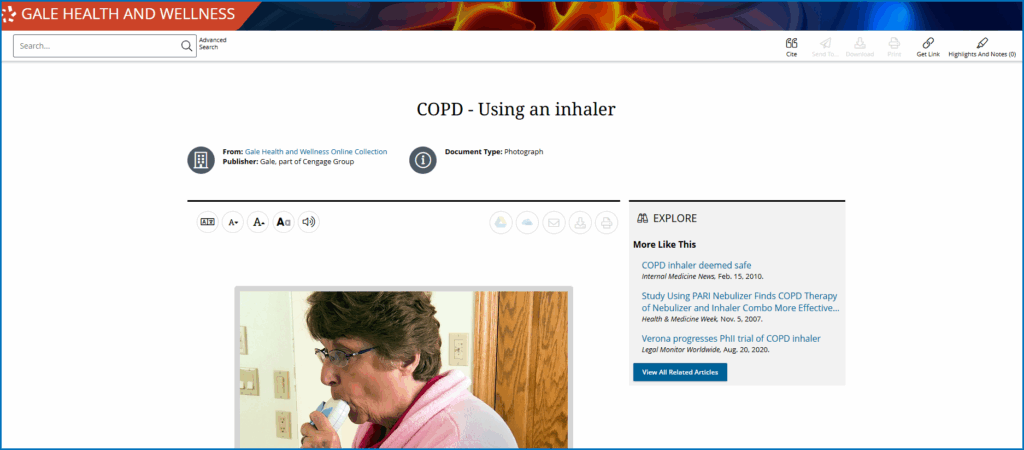Nearly 16 million people in the U.S. have chronic obstructive pulmonary disease, more commonly known as COPD. Domestically, it remains one of the top 10 leading causes of death. Internationally, it ranks even higher—especially in developing countries.
World COPD Day is November 19. This year’s theme, “Short of Breath, Think COPD,” highlights that many individuals lack adequate treatment due to improper diagnoses. It’s an important opportunity to share critical information, including risk factors, healthy lifestyle habits, and treatment options.
In preparation for World COPD Day, we’re highlighting key information—and how Gale Health and Wellness can help connect patrons with content that’s reliable, accessible, and relevant to their overall health and well-being.
Understanding Different Types of COPD
Chronic obstructive pulmonary disease (COPD) is an umbrella term referring to a group of progressive respiratory disorders characterized by inflammation in the lung tissues, resulting in airflow obstruction. People with COPD typically experience wheezing, coughing, and excess mucus production. COPD is incurable and gradually progresses over the course of several years.
The most common types of COPD are chronic bronchitis, emphysema, and lung scarring due to refractory asthma:
- Chronic bronchitis is characterized by an inflammation and tightening of the bronchial tubes, the passageways that enable air to enter and leave the lungs. This inflammation contributes to chronic coughing and excessive mucus production, leading to persistent shortness of breath. Lung infections may become common when the cilia, the tiny hair-like projections that line the bronchi, are damaged by cigarette smoke and other irritants.
- Emphysema is another condition associated with COPD, occurring when the alveoli, or tiny air sacs in the lungs, become enlarged and damaged. People with emphysema experience coughing, increased mucus production, and difficulties with exhaling and breathing deeply. This disease is also progressive, and no cure currently exists.
- Refractory asthma, which accounts for about 10% of all asthma cases, is challenging to treat and doesn’t respond well to most asthma medications. Like other COPD conditions, refractory asthma is characterized by bronchial tube inflammation, resulting in increased mucus production. A person with this condition has typical asthma symptoms, including coughing, wheezing, and shortness of breath.
COPD Risk Factors
Certain risk factors may predispose people to COPD. In the United States, smoking tobacco products is the most significant threat. In high-income countries, such as the U.S., at least 70% of COPD cases are primarily related to tobacco smoking. Vaping, smoking pipes or cigars, and inhaling secondhand smoke can also raise your risk.
In developing countries, only 30–40% of COPD cases are primarily tobacco-related. Instead, a greater proportion of cases are related to environmental and occupational exposure to inhaled chemicals, dust, fumes, and toxins. Industries with elevated occupational risks include mining and textile manufacturing. In developing countries, fumes from cooking and heating fuel at home are another significant risk factor.
In other cases, genetics is the main cause. Some individuals, especially those with emphysema, may not produce enough alpha-1-antitrypsin (AAT)—a protein necessary for healthy lung tissue. The deficiency of this protein causes lung tissue to break down and can lead to emphysema developing between the ages of 30–40.
For individuals with COPD, exposure to outdoor air pollution and indoor contaminants, such as fumes and secondhand smoke, can exacerbate symptoms and trigger flare-ups. COPD can raise the risk for other health problems, like lung cancer and heart disease. It also makes someone more vulnerable to pneumonia, acute respiratory distress syndrome, and COVID-19.
For a more in-depth look at COPD risk factors, you can guide patrons to the plain-language articles and multimedia resources in Gale Health and Wellness.
Check out our introductory video on how to get started with Gale Health and Wellness.
COPD Symptoms
Because lung damage worsens gradually, it can potentially take years before the first serious complications from COPD emerge. A formal diagnosis may take time. The condition is characterized by a daily cough and mucus production for three or more months per year for at least two consecutive years.
Potential COPD symptoms include:
- Excessive mucus in the morning, with a clear, white, yellow, or green color
- Shortness of breath, especially after physical activity
- Frequent lower or upper respiratory infections
- Blue color around the lips and fingernails
- Unexplained weight loss
- Chronic cough
- Tight chest
- Wheezing
- Fatigue
There isn’t a single test for COPD, so doctors rely on a combination of symptoms to arrive at a diagnosis. In addition to performing a physical exam and considering patient symptoms, a doctor may also use X-rays or CT scan imaging, conduct blood tests, and have a person breathe into a spirometer—a device with a tube that measures airflow in and out of the lungs.
Patients should work closely with their medical team to evaluate symptoms, run tests, and discuss a care plan. Before or between appointments, your patrons can depend on Gale Health and Wellness as a trusted resource. Our team of experts designed the database with the general public in mind, including a suite of accessibility tools to empower all members of your community with adjustable font size, text-to-speech ReadSpeaker technology, translation into dozens of languages, and more. Spanish-language material is also available via Relay Clinical Education.
Understand Ways to Treat COPD and Maintain Quality of Life
With an accurate COPD diagnosis, a physician can develop a comprehensive, long-term treatment plan to alleviate symptoms, prevent further complications, and slow the progression of the disease. Treatment options have improved significantly over the years, transforming COPD into a manageable condition.
To relax the muscles in the lungs and chest, a doctor may prescribe a bronchodilator, taken with a handheld inhaler or nebulizer. This allows for more open airways. Individuals with emphysema due to AAT deficiency may try augmentation therapy, which involves weekly or bi-monthly injections of AAT derived from healthy blood.
Some patients rely on oxygen therapy, which delivers oxygen either through a small tube just inside the nose or a mask over the mouth and nose. The oxygen typically comes in containers small enough to be carried at home or when traveling.
Depending on the patient’s preferences, medical needs, or nature of their COPD, a doctor may also prescribe antibiotics, corticosteroids, or other oral medications. To prevent COPD-related complications, patients should maintain their regular vaccinations and booster shots for pneumonia, the flu, COVID-19, and other lung infections.
COPD management could also include at-home remedies. For instance, taking over-the-counter (OTC) expectorants can help loosen and expel excessive mucus. In addition to medication, maintaining healthy habits is crucial for reducing flare-ups, preventing complications, and enhancing overall well-being. People with COPD should avoid or quit smoking, eat a healthy and balanced diet, minimize exposure to environmental pollutants, and exercise regularly, as able.
Effective treatment also requires regular doctor visits and ongoing communication with a medical team to manage symptoms and make necessary adjustments to medications. It’s a good idea to write down questions ahead of time and take them with you to your appointment.
- Which OTC medications would you recommend to manage symptoms?
- What are the keys to slowing the progression of COPD?
- Are there potential complications or other infections I should be aware of?
- Are there exercises that can help improve my breathing?
Partner with Gale for Year-Round Wellness
Your library is already a trusted community partner. With Gale Health and Wellness, you can further support your patrons as a vital link to reliable, up-to-date information about COPD and hundreds of other health conditions. Gale Health and Wellness is medically sound and ad-free, without potentially misleading sponsored content or pop-ups.
Partnering with Gale means you can empower your patrons to make informed health decisions and safeguard their well-being. For more information on how to get started, contact your local representative.




